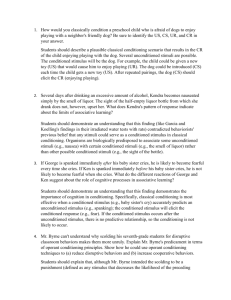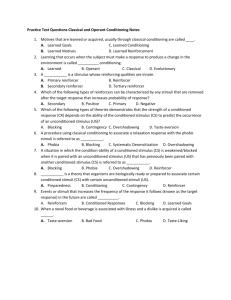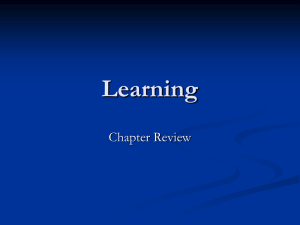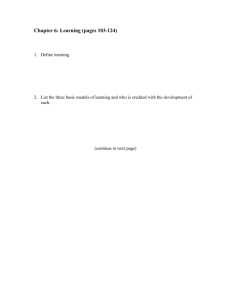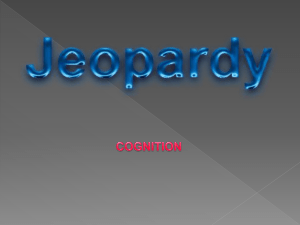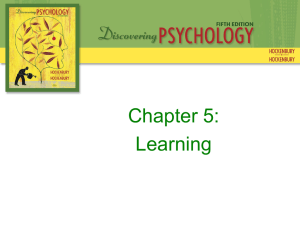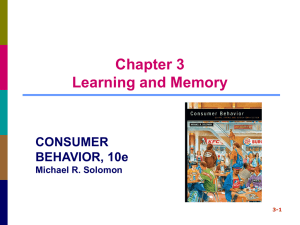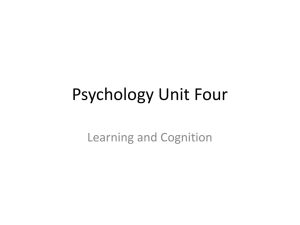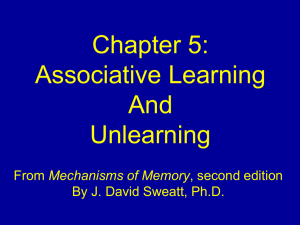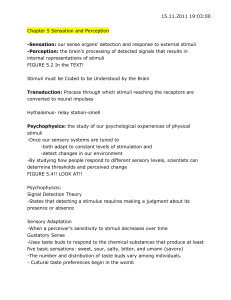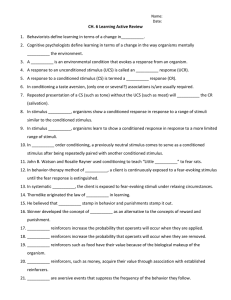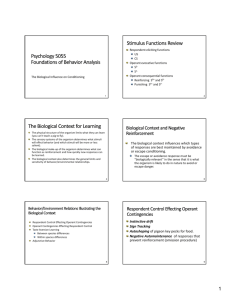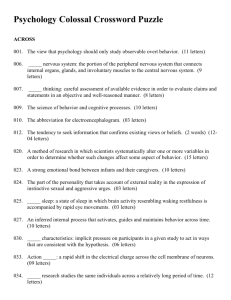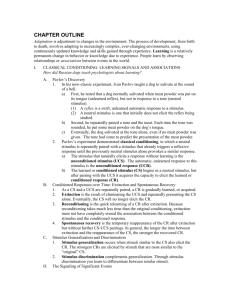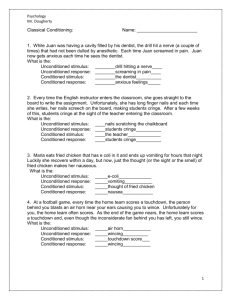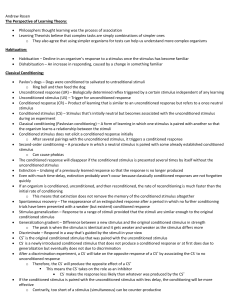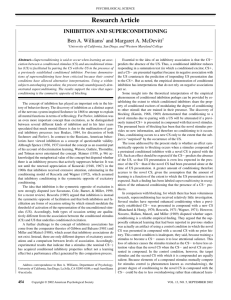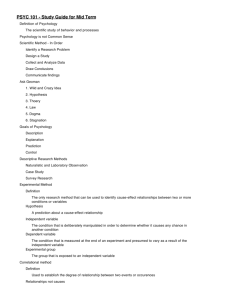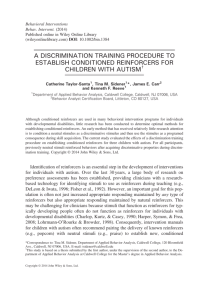Glossary of Key Terms
advertisement
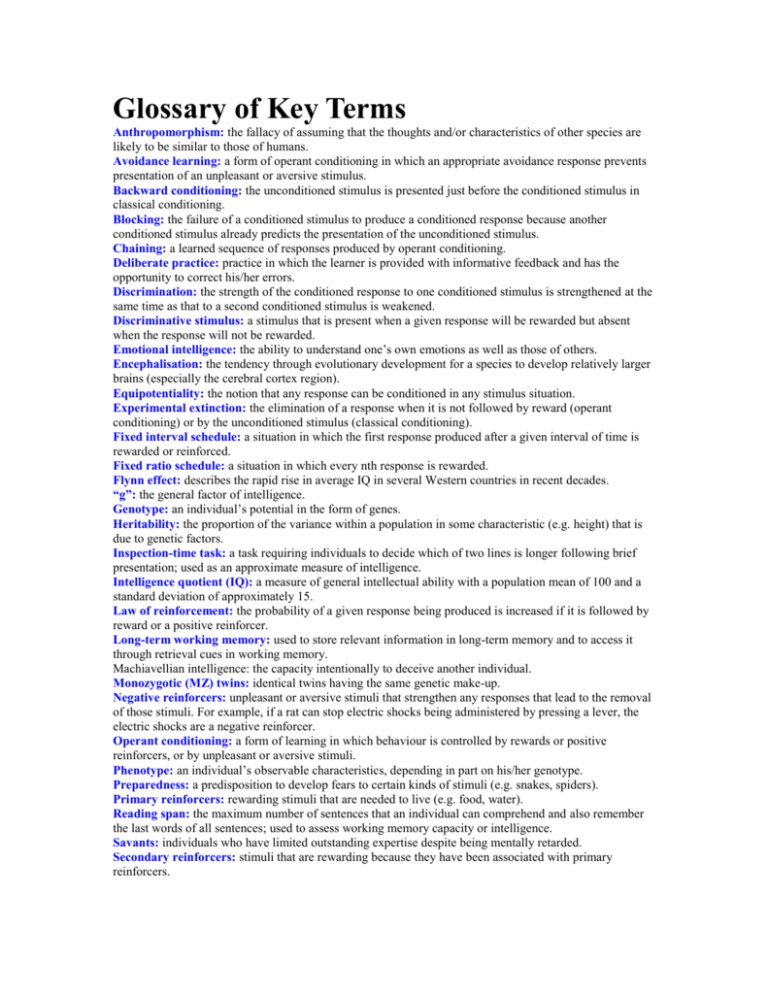
Glossary of Key Terms Anthropomorphism: the fallacy of assuming that the thoughts and/or characteristics of other species are likely to be similar to those of humans. Avoidance learning: a form of operant conditioning in which an appropriate avoidance response prevents presentation of an unpleasant or aversive stimulus. Backward conditioning: the unconditioned stimulus is presented just before the conditioned stimulus in classical conditioning. Blocking: the failure of a conditioned stimulus to produce a conditioned response because another conditioned stimulus already predicts the presentation of the unconditioned stimulus. Chaining: a learned sequence of responses produced by operant conditioning. Deliberate practice: practice in which the learner is provided with informative feedback and has the opportunity to correct his/her errors. Discrimination: the strength of the conditioned response to one conditioned stimulus is strengthened at the same time as that to a second conditioned stimulus is weakened. Discriminative stimulus: a stimulus that is present when a given response will be rewarded but absent when the response will not be rewarded. Emotional intelligence: the ability to understand one’s own emotions as well as those of others. Encephalisation: the tendency through evolutionary development for a species to develop relatively larger brains (especially the cerebral cortex region). Equipotentiality: the notion that any response can be conditioned in any stimulus situation. Experimental extinction: the elimination of a response when it is not followed by reward (operant conditioning) or by the unconditioned stimulus (classical conditioning). Fixed interval schedule: a situation in which the first response produced after a given interval of time is rewarded or reinforced. Fixed ratio schedule: a situation in which every nth response is rewarded. Flynn effect: describes the rapid rise in average IQ in several Western countries in recent decades. “g”: the general factor of intelligence. Genotype: an individual’s potential in the form of genes. Heritability: the proportion of the variance within a population in some characteristic (e.g. height) that is due to genetic factors. Inspection-time task: a task requiring individuals to decide which of two lines is longer following brief presentation; used as an approximate measure of intelligence. Intelligence quotient (IQ): a measure of general intellectual ability with a population mean of 100 and a standard deviation of approximately 15. Law of reinforcement: the probability of a given response being produced is increased if it is followed by reward or a positive reinforcer. Long-term working memory: used to store relevant information in long-term memory and to access it through retrieval cues in working memory. Machiavellian intelligence: the capacity intentionally to deceive another individual. Monozygotic (MZ) twins: identical twins having the same genetic make-up. Negative reinforcers: unpleasant or aversive stimuli that strengthen any responses that lead to the removal of those stimuli. For example, if a rat can stop electric shocks being administered by pressing a lever, the electric shocks are a negative reinforcer. Operant conditioning: a form of learning in which behaviour is controlled by rewards or positive reinforcers, or by unpleasant or aversive stimuli. Phenotype: an individual’s observable characteristics, depending in part on his/her genotype. Preparedness: a predisposition to develop fears to certain kinds of stimuli (e.g. snakes, spiders). Primary reinforcers: rewarding stimuli that are needed to live (e.g. food, water). Reading span: the maximum number of sentences that an individual can comprehend and also remember the last words of all sentences; used to assess working memory capacity or intelligence. Savants: individuals who have limited outstanding expertise despite being mentally retarded. Secondary reinforcers: stimuli that are rewarding because they have been associated with primary reinforcers. Shaping: using reward or reinforcement to produce progressive changes in behaviour in a desired direction. Social learning: the theory that behaviour can be explained in terms of both direct and indirect (vicarious) reinforcement; indirect reinforcement and identification lead to imitation; also used more generally to refer to any learning that occurs within a social context. Spontaneous recovery: the re-emergence of responses over time following experimental extinction. Standard deviation: a measure of the spread of scores in a bell-shaped or normal distribution. It is the square root of the variance, takes account of every score, and is a sensitive measure of dispersion or variation. Tradition: distinctive patterns of behaviour that are found in several members of a social unit over a long period of time. Variable interval schedule: on average the first response produced after a given interval of time is rewarded, but with some variation around that time interval. Variable ratio schedule: on average every nth response is rewarded, but there is some variation around that figure. Working memory: a system having the functions of cognitive processing and the temporary storage of information.

